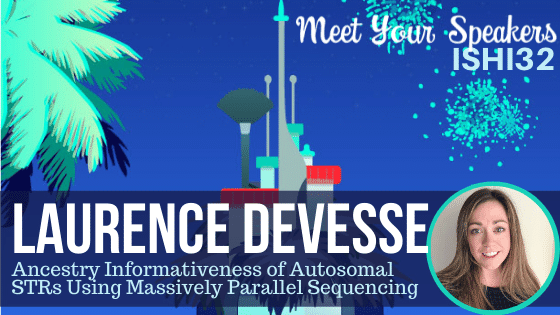The ability to estimate the geographic ancestry of a donor from a forensic sample can be of vital importance for so called “no-suspect, no-hit” cases. It is a tool that can provide information to law enforcement and enable prioritisation of specific lines of enquiry. Traditionally, this has relied on the use of specific ancestry informative single nucleotide polymorphisms (SNPs), run as an additional test to short tandem repeat markers (STRs). STRs have largely been discounted for geographic ancestry determination due to their high mutation rate, which in turn makes them well suited for individual identification. Being able to obtain a DNA profile that can simultaneously be used for geographical ancestry estimation and searching against offender databases would be a huge benefit to the field of forensic identification in terms of time, cost and sample availability.
In her presentation at ISHI 32, Laurence Devesse addresses the discovery and characterisation of novel sequence variants, and the opportunity to utilize this diversity in unique ways. In particular, the presence of population-specific sequence variation raises the prospect of using STR profiles for population identification, both on their own and in combination with ancestry-informative SNPs.
We chatted with Laurence to learn how the method she describes will allow SNP tests to run in tandem with STR testing and the value of using STRs for ancestry estimation.
Traditionally, why are SNP tests unable to be run in tandem with STR testing? Why has there been a need to run two tests?
The method for analysing SNPs and STRs was always different, and so they couldn’t be run together. This means that when dealing with a DNA sample, a choice had to be made for what technique to try first – which is normally always STRs as they have a higher power of discrimination for individual identification. Then, if a profile led to no identification (no database hit, no suspect match), maybe something like an ancestry SNP panel would be run to provide the investigation with further information. This requires more sample, more time and more testing.
How will the method you explore in your presentation allow the two to be analyzed together?
The ForenSeq DNA Signature Prep Kit already allows for the amplification of autosomal STRs and ancestry-informative SNPs (as well as some other markers) in tandem, meaning all the data for the two different types of testing is obtained at once. My research aims to see whether, through a different way of looking at the data, we could combine the autosomal STRs with the ancestry informative SNPs to increase our ability to estimate the bio-geographical ancestry of a sample, whilst simultaneously obtaining an STR profile for identification.
What is the value of using autosomal STRs for ancestry estimation?
Because STRs are almost always targeted first in forensic DNA investigations, the data is “already there” in most cases. If there isn’t the opportunity to run an additional panel, then ancestry information hidden in the STR results may provide broad, continental differentiation without the need for additional testing or sample.
Were there any surprises that arose in your research?
When doing a PhD, twists and turns are always expected, but this is especially true when doing it part-time as more time taken to do it means more time for the field to change! When I started my PhD, everyone was excited about the sequence variation we could see in the repeat regions of STRs. Part-way through, new guidelines were published that suggested that it was important to also analyse flanking regions. I had to go back to square one for analysing my data, which was scary but also gave me an opportunity to look at things in a different way.
Do you have any advice for labs looking to implement a MPS workflow?
Don’t be scared of embracing something new! There are so many exciting advances in the field of forensic genetics thanks to MPS – think of where it would fit into your workflow and what it could bring. Also, don’t be afraid to ask around because there are a lot of potential collaborations to be made out there.
What tips would you give to someone who is just starting out in the field of forensics, or what is the best advice that you’ve received?
I would say that passion for the topic goes a long way in the field of forensics, and you’re likely to meet a lot of very passionate people. Try to network as much as possible. Every person I have met in the field has given me fresh insights and inspired me. One of the best pieces of advice I was ever given was to always take any opportunity to present your work – even if you’re nervous, each presentation is practice for the next one.
What is your favorite Disney character and why, or which Disney character do you most relate to and why?
There was a mouse in Cinderella, I think his name was Gus? There was a scene where he tried to carry too much cheese – it makes me laugh every time I think of it.
If you could have one superpower, what would it be and why?
Time travel, so that I could go back in time to chat to loved ones and a few famous scientists. A hop into the future to read my finished thesis wouldn’t go amiss either.
What’s one thing that others may not know about you?
I grew up in Belgium, and my first language is actually French. When I first moved to England for university, a lot of people thought I was a Belgian princess (I’m not!).
WOULD YOU LIKE TO SEE MORE ARTICLES LIKE THIS? SUBSCRIBE TO THE ISHI BLOG BELOW!
SUBSCRIBE NOW!


